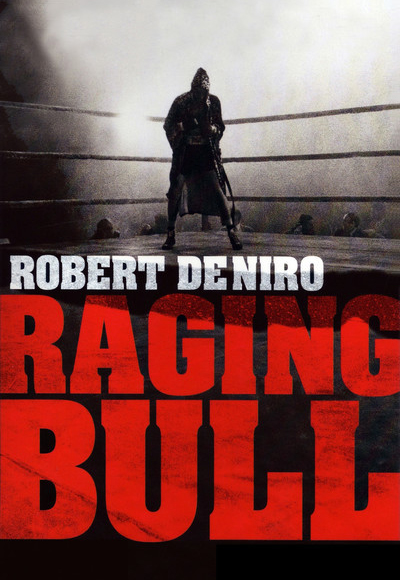Raging Bull
- 14 Feb 2016
- The sights and sounds of its boxing scenes are outdated, but like other good movies about boxing, it's not only about boxing.

I was looking for an excuse to finally watch Raging Bull and then write about it. I found that excuse, a week ago, when I was browsing The Guardian app on my phone. I saw an article about the Valentine’s Day boxing match between “Sugar” Ray Robinson and Jake La Mota, and I decided to rent the movie about La Motta. Today is the 65th anniversary of that bout, which is the climax of the movie.
I’ve been listening to “Intermezzo” by Pietro Mascagni for about a month. It’s more commonly known as “the Raging Bull theme” because the movie is so famous. The song is also used in The Godfather Part III, though I don’t remember when. An episode of The Sopranos and the director’s cut of Watchmen pay homage to the movie: in both cases, the theme plays while characters box outside of a ring, although in totally different situations.
The Sopranos is noteworthy because it features an actor who has a similar role in Raging Bull. In “The Blue Comet,” the previously mentioned episode of The Sopranos, the song plays in a restaurant after Tony Soprano and his confidants make a decision about their feud with Phil Leotardo, a frenemy mob boss who’s played by Frank Vincent. In Raging Bull, Vincent plays Salvy, a local mobster who is kept at arms-length by Robert De Niro’s La Motta.
De Niro portrays a man who is tough like a bull and stubborn like one, too. He refuses to reach out to Salvy and the mob even though they can guarantee a chance at the the middleweight championship. Joe Pesci’s Joey tries to convince Jake to collaborate with them, but the older brother wants to be the champ through merit, not manipulation. The man does intentionally lose a match, but he refuses to take a dive and he’s inconsolable afterward.
Pride keeps La Motta on his feet, whether he’s losing (intentionally) to a chump or losing (overwhelmingly) to a champ. After being completely pummelled by Robinson into a technical knockout, La Motta declares, “You never got me down, Ray.” Inside the ring, he’s defiant and proud. Outside the ring, he’s demanding and jealous. La Motta seems to perpetually simmer with destructive rage like his nickname suggests.
The most poignant scene is La Motta finally realizing his folly. Hysterical, he unleashes a flurry of low punches and even some headbutts against a wall of his jail cell. The second-most poignant scene is La Motta later doing a standup routine in a New York bar that pales in comparison to the Miami nightclub that he’d previously owned. The movie has a hopeful ending, though, because it depicts La Motta preparing to perform at a classier venue.
More importantly, the Raging Bull has, by this time, become the Knowing Bull.
I understand why Raging Bull is critically acclaimed, but it’s not my favorite drama about a boxer. Boxing is naturally cinematic, but the depiction of “the sweet science” in Raging Bull is corny. The punches look and sound obviously fake, but at least the amount of boxing is minimal. I applaud the hair and makeup styling because De Niro and Pesci plausibly look like brothers for most of the movie. Cathy Moriaty is beautiful as La Motta’s second wife.
I learned about De Niro’s famous transformation when it was mentioned during an episode of Entourage. I respect his dedication that had led him to gain 80 pounds for the portrayal of La Motta when the man’s boxing career is over. In my opinion, Michael Cimino’s The Deer Hunter beats Martin Scorsese’s Raging Bull as the best movie in which De Niro is the lead character, I don’t count The Godfather Part II and I haven’t seen Taxi Driver.
Overall, I was captivated by Raging Bull. I was disappointed when I realized that I’d already seen the best scenes on YouTube, though. The movie was like a highly touted, pay-per-view bout that ended with a bona fide knockout after six rounds. I hadn’t known about Jake La Motta, until reading about this movie, which is based on his autobiography. I was surprised when I learned that he was in the Knockout Kings and Fight Night video games.
Of course, now I understand why he’s a boxing legend, for reasons good and bad.